Warning before you read this: I get heavily invested into video game stories. Crazy, I know. I mean, it’s not like people get so invested in other media, such as movies, to the point that they chase directors off of Twitter. I really delve into the story of two games in this post and provide quite a bit of analysis. You’ve been warned!
This post contains spoilers for Tales of Xillia and Tales of Xillia 2.

A case study in unfinished games: Tales of Xillia
In Japan, Tales of Xillia, the thirteenth entry in the Japanese RPG Tales of series, was marketed as the 15th anniversary title with a rather ambitious scope. The game would feature two main protagonists with their own separate stories in the game. The game was also the first in the series to feature animated cutscenes from the talented animation studio ufotable who are known for their stunning animation and use of computer graphics.
…Unfortunately, ambition does not always translate into execution. For reasons that I do not know, Xillia was rushed to release in order to meet the 15th anniversary deadline. Unlike Square Enix, whose directors occasionally do interviews with English-speaking game publications, Bandai Namco is a black box when it comes to the Tales of series, especially outside of Japan. Hideo Baba, the (now former) producer of the series, had pushed for more Tales of games being released in the West when the series had mostly stayed in Japan in the past. For that, I’ve always appreciated Baba’s efforts. He even traveled to conventions in Europe and North America to promote the series to fans. I can’t claim to know what he actually did as producer for the series. But I will say this: he lies to fans. A lot.
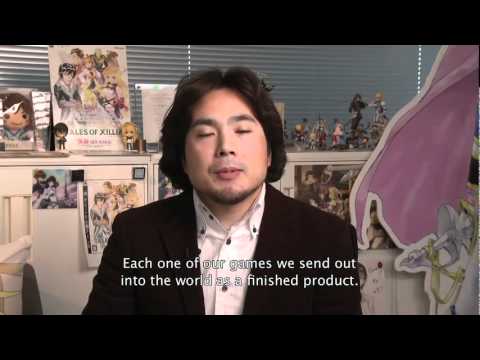
Okay, so you’re a major publisher of Japanese RPGs and you just rushed the 15th anniversary title in one of your big JRPG series to release. Fans are, understandably, unhappy about this considering how much the game was hyped up in its advertising. It’s okay, though! You can fix this! Just re-release the game a year later with improvements! Oh wait, you’ve already done that a bunch of times before. Okay, how about a Director’s Cut! Oh wait, you’ve done that, too. Okay, hmmm… I’ve got it!
MAKE A SEQUEL!
(And this is where everything starts going to hell.)
A win-win situation: Minimal effort required
Welp, you didn’t initially plan for a direct sequel to the game. But hey, direct sequels have their benefits. You can re-use assets from the first game! So development will be faster and cheaper. You’ve also got an established cast of characters to work with! An already established setting! No problemo!
I mean, look at Final Fantasy XIII-2. It was an unplanned direct sequel to Final Fantasy XIII and it worked out fine. All it did was retcon the ending to the first game that had wrapped up the story so neatly and nicely. And as an excuse to re-use assets Final Fantasy XIII-2’s developers made up a terrible time-travel story. So what could go wrong with a quick, easy sequel to Tales of Xillia?
…Oh, crap.
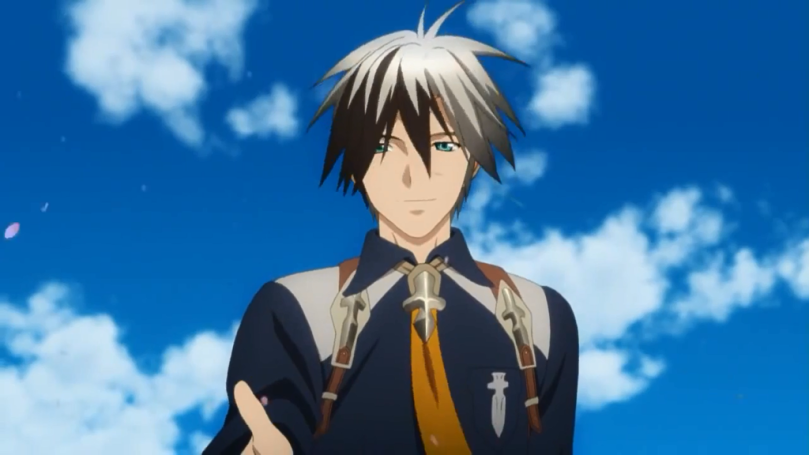
When bad game development practices direct the story’s path
I’d argue that skillful writing allows a plot to develop organically. Entire plot elements that were never hinted at before should not be thrown at the reader/viewer/player/whatever completely out of left field without at least foreshadowing it before. A lot of writers fail to do this and in my experience, the plot suffers for it. Tales of Xillia 2 is an excellent example of this kind of writing failure.
So what excuse did the developers come up with to reuse assets from the first game?
ALTERNATE DIMENSIONS!!!
Nevermind that these alternate dimensions were not even so much as hinted at in the first game. Nevermind that a non-playable character mentioned in the backstory for the first game had most of her story retconned to fit these wonderful plot devices into the game.
In Xillia 2’s story, the main character has a special ability that lets him destroy alternate dimensions because… plot. In any case, the moral implications of destroying entire dimensions are lightly touched on but mostly swept under the rug throughout the course of the game. Kind of odd considering that the main characters’ motivation at the end of the first game was to find a way to avoid sacrificing one world so that another could survive. That’s all out the window, now, apparently. There actually is a character who does a good job of bringing up these moral implications… and she also gets swept under the rug (or thrown in the fridge).
The weird thing about this plot point is that games in the Tales of series have generally focused on themes that advocate avoiding sacrifice no matter what. Characters always find another way to avoid having to sacrifice others. And while I think it’s fine to go against this theme every now and then, Xillia 2 is a sequel to a game that adhered to that same theme. A main part of Xillia’s story was the idea of not having to sacrifice an entire world so that another can thrive. Xillia 2’s story carelessly throws this theme out the window for the sake of cheap melodrama.
Xillia 2 is known for a having a dark story. Unfortunately, many confuse a dark story with a good story. I’d never really put much thought into the concept until I played this game. There is a difference between a sad or dark story that is written well and one that is written to be emotionally manipulative. Xillia 2’s story felt like the latter. When I feel like someone or something is trying to manipulate my feelings, I get really defensive. Yes, bad things happen over the course of Xillia 2. People die. Hard decisions are made. But it never really felt “real” to me. I felt like the characters were robbed of agency just so the plot would make certain melodramatic turns. Like the main scenario writer for the game was moving manikins before my eyes rather than telling an actual story and letting the plot flow naturally.
At one point in the story we find out that to proceed, an important character’s life must be sacrificed. In the first game, the main cast would have vehemently opposed this idea and done whatever they could to find another way. As mentioned before, a lot of Tales of games’ stories were driven by a need to avoid sacrificing others.
As a game that is supposed to be attached to Xillia, the scene where this character agrees to give up his life feels so dissonant thematically. The main cast from the first game just shrug and figure there’s no other way to proceed. So they sit back and allow this person to be sacrificed. Compared to the first game, the scene feels so wrong. And this is a problem I encountered a lot in Xillia 2. Characters are robbed of agency for the sake of drama.
Ms. Fractured Milla in the Fridge
For example, the character I mentioned earlier that actually serves as a great example of the moral implications of destroying alternate dimensions is never given agency throughout the entire game. In the game she’s known as “Fractured Milla” because she is an alternate dimension counterpart to a character (Milla Maxwell) from the first game. Fractured Milla is first introduced after the world she lives in gets destroyed. After this point she joins the party, and her presence brings up uncomfortable questions for the main cast about whether what they’re doing is right or not. I really liked the tension she brought into the story.
According to the game’s development staff, Fractured Milla was not originally meant to play as large of a role as she did in the final product. In fact, she’s really just a gimmick character. Fractured Milla has no agency whatsoever from the point she is introduced to the point where she is cheaply killed off for the sake of, once again, cheap melodrama. Her death is meant to mirror her counterpart’s sacrifice, which was a major part of the story in the first game. However, in the first game (regular) Milla sacrifices herself because she chooses to save her friends. Fractured Milla, on the other hand, does not really have a choice in the matter. She very obviously does not want to sacrifice herself when she does die. That the game tried to equate the two characters’ choices struck me as incredibly disingenuous.
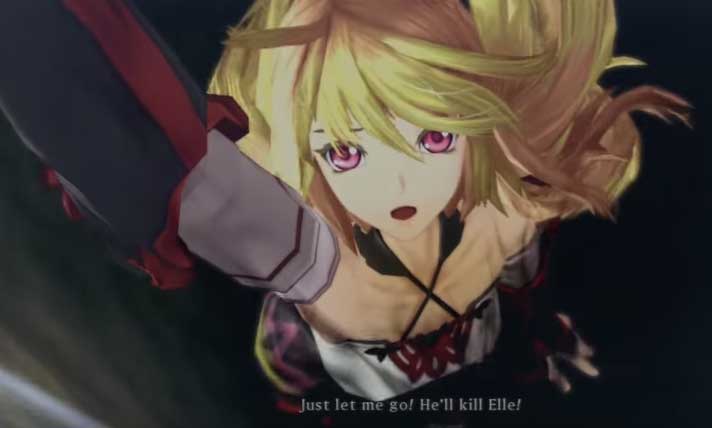
The website TV Tropes has a great description for the situation this character is placed in. They term it being ‘fridged’ (as in: a female character being stuffed into a refrigerator).
A character is killed off in a particularly gruesome manner and left to be found just to offend or insult someone, or to cause someone serious anguish. The usual victims are those who matter to the hero, specifically best buddies, love interests, and sidekicks. In some cases, the doomed character may be killed by natural forces or by a character who doesn’t have the intent to cause someone else angst — in this case, the intent comes from the writer, who wants to rouse strong emotions in another character.
While it is strictly true that Tropes Are Not Bad, this one, especially as a catchphrase, is often given a very negative connotation as it is all too often a hallmark of supremely lazy writing – using the death of a character as “cheap anger” for the protagonist, and devaluing the life of that character in the process, instead of giving the villain something actually interesting to do that can involve all three characters and more emotions than simple anger and angst.
In the case of Xillia 2, this female character never even gets to leave the fridge. She is thrown into the plot to create pointless angst and then thrown away as soon as she stops serving her purpose. To add insult to injury, Fractured Milla is replaced immediately afterward and from that point on, she is hardly mentioned by the rest of the cast with the exception of one character. Her death isn’t really explored in the plot, either. She simply dies, is replaced, and the story moves on. Fractured Milla’s character ‘arc’ is a major reason why I think Xillia 2’s writing is objectively worse than the first Xillia’s. The first Xillia wasn’t as blatant as to introduce a character and then kill them off in this manner. Instead, the game developed characters gradually over time. When characters in the first Xillia were killed in the narrative, I actually cared (for the most part). Or even if I didn’t, I could agree that their death was significant in some way because I knew the character’s history and how it fit in with the rest of the game’s story. Xillia 2 instead throws in characters whose only purpose in the plot is to die and appeal to the player’s emotion. Minimal development required.
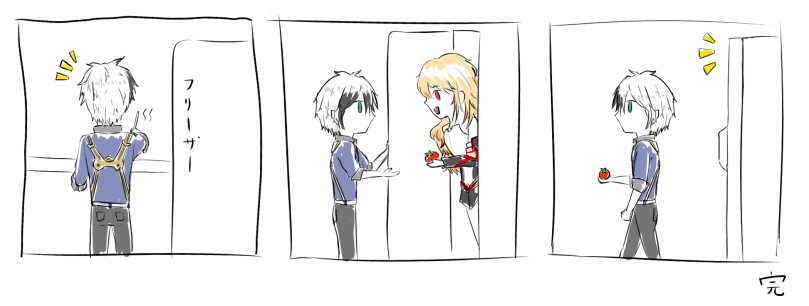
“Tell” Instead of “Show” Characters
Speaking of characters who are cheaply killed off… Another major character in the story is the main character Ludger’s big brother, Julius. While he has more agency than Fractured Milla, he is also absent from the screen for most the story. We are told that he has gone into hiding, which makes sense in context of the story. However, this also means that the brother as a character ends up being more of a ‘tell’ character than a ‘show’ character as you end up hearing about him more than actually seeing him.
Characters that spend most of their time off-screen can be done well. Unfortunately, Xillia 2 doesn’t do this well, either. Julius’s absence is a problem when the game’s story relies heavily on the bond between him and Ludger. Ludger is a silent protagonist, so he can’t really express himself much when it comes to his brother. The most we get to see is him looking upset in scenes involving his brother. So how does the game try to get the player to care about Julius? By telling the player to care about him.
Since Ludger can’t speak for himself, you get to hear from other characters and non-playable characters (NPCs) about how much Ludger loves his brother. And believe me, Ludger really loves his brother! Like, seriously! He really, REALLY does!
This relationship culminates in a scene where Ludger has to kill his brother for (once again, contrived) plot reasons. Before Ludger stabs his brother through the chest, the player is shown a brief animated cutscene showing the relationship between the two brothers. It shows Ludger’s day to day life with Julius, the way he took care of him, and so on. The scene is meant to show just how hard it is for Ludger to kill his brother. And you know what, it is a touching scene. All ten seconds of it. It went by so fast that I hardly had time to even process it before Ludger dramatically kills his brother.
I felt so cheated by the game at that point. I’d have loved to see that kind of development throughout the game instead of a bunch of characters and a cutscene just telling me to care about Julius. Why not have more flashbacks throughout the game instead of a ten second animated cutscene toward the end of the game? Why not allow Julius to show up more so that I could at least have more of a reason to care about him?
There’s actually another Japanese RPG with a silent protagonist that does an excellent job of making the player care for the main character and his brother. That game is Mother 3. Unlike Xillia 2, Mother 3 has no voice acting. It doesn’t have pretty boy characters. It doesn’t have animated cutscenes. Mother 3 is an RPG for the Game Boy Advance that just had really, really good writing. The ending of that game practically had me in tears because it really managed to make me care about the main character’s bond with his brother. The difference between Mother 3 and Xillia 2, aside from bells and whistles, is the writing. Shigesato Itoi, who heads the Mother series and writes the plots for the games, is an actual writer outside of video games. And it shows. Mother 3 has some scenes that are viscerally striking. I feel like the difference between Xillia 2 and Mother 3 in terms of writing is like comparing the Eragon Inheritance series to Lord of the Rings.
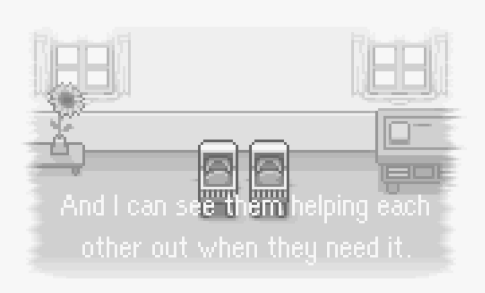
Ludger the Gary Stu, is there anything he can’t do?!
Now I direct you to the Super Special Awesome Protagonist-That-You-Must-Love: Ludger Will Kresnik!
Having lived a relatively normal life where he was quiet and shy and didn’t have many friends, he suddenly finds himself becoming best friends with the cast from the first Xillia; all of whom warm up surprisingly quickly. Despite only having some combat training from his older brother, he’s somehow far more powerful than the characters in the first game who in some cases have years of combat experience! He can also use all of their special abilities in battle. And he has a powerful transformation mode.
Right.
This is the type of character that many would call a ‘Mary Sue’ (or Gary Stu, in the case of male characters).
Definition of a Mary Sue/Gary Stu taken from Fanlore:
A Mary Sue/[Gary Stu] is an original character in fan fiction, usually but not always female, who for one reason or another is deemed undesirable by fan critics. A character may be judged Mary Sue if she is competent in too many areas, is physically attractive, and/or is viewed as admirable by other sympathetic characters. Mary Sues are generally presumed to be idealized self-inserts rather than true characters, although they may actually be intended as proxies for the reader. In fan fiction, it is considered extremely gauche, or at least very immature, for an author to create characters based on him- or herself.
“Mary Sue” is an extremely subjective value judgement. One fan’s Mary Sue may be another fan’s awesome woman action hero. Someone at TvTropes observed that “Mary Sue” is actually the reaction that fans may have to a work that “is unduly favoring a character by changing other characters or the environment in inappropriate ways. When the audience calls “Mary Sue” on a character, the author has shattered their Willing Suspension of Disbelief.”
Mary Sue type characters do exist in both fan fiction and canon. The main difficulty with true Mary Sue stories is that they often cause canon characters, established story lines, and the very inner consistency of the canon’s reality, to behave wildly out of bounds.
Welcome to fanfiction plot devices… in a $60 video game for the Playstation 3!
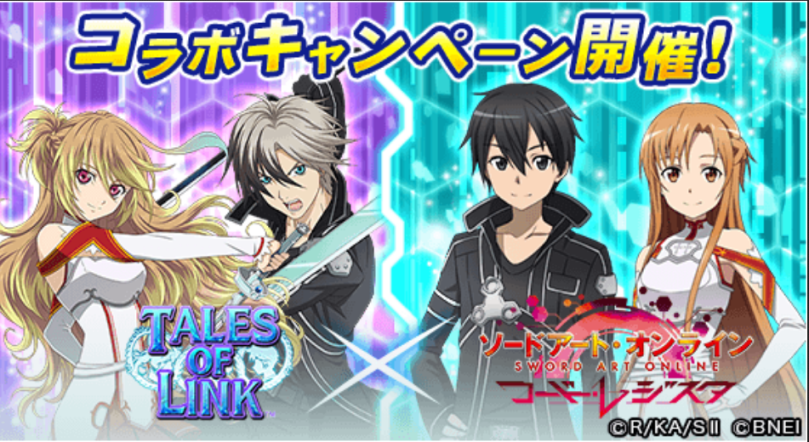
As the definition states, the label of Mary Sue/Gary Stu is highly subjective. And I don’t label Xillia 2’s main character, Ludger Will Kresnik, as a Gary Stu lightly. But let’s take a look at some of the points I emphasized in the definition.
presumed to be idealized self-inserts rather than true characters
Ludger is a silent protagonist in a series known for its voice acting and heavy emphasis on character interactions. I am not entirely sure of the reason behind making him a silent protagonist, though I have my theories. In any case, the player is meant to think of him or herself as Ludger in the game. Plenty of RPGs, usually games with Western origins, tend to operate with this premise. For a Japanese example, there’s the Persona series from the third game onward. However, those games are designed for having a self-insert as the protagonist. Dropping a silent self-insert protagonist into a game with a pre-established universe, let alone as a sequel instead of a standalone title is incredibly jarring. Ludger never felt like a ‘real’ character to me as a result.
Ludger as a character is not grounded within the world set up in the first Xillia. He comes out of nowhere and is thrown at the player. There is no sign of him or most of his rather influential family in the first game (yet another sign that this sequel was hastily thrown together and not originally planned). He has no real prior connection to the main cast aside from his last name. And even that detail required a retcon in the first game’s story to even work. His existence felt very intrusive to an already established world.
For example, in Final Fantasy XIII-2, the sister of the main character from the first game, Serah, serves as one of the new protagonists. Serah played a minor role in the first game; so she was an already established character. A new male character, Noel, is introduced who ends up meeting her and joining her on her quest. Serah serves as a character that grounds Noel within the world. Yes, Noel sort of comes out of nowhere, but through his interactions with Serah, I felt that he had at least some connection to the cast from the first game and thus the world in general.
This isn’t the case with Ludger at all.
competent in too many areas
Compared to the surprisingly well rounded and realistically written characters from the first Xillia, Ludger is a walking power fantasy. For instance, in the first game each character in the six-person main cast has an explanation for why they are proficient at combat. These explanations fit in well with their respective backstories and serve to give the sense that they are talented in certain areas but not with others. Ludger, on the other hand, picks up weapons he’s never used and becomes proficient with them immediately. Unlike the rest of the cast, Ludger can switch between three different weapons: dual blades, hammer, and gun. His proficiency with dual blades is explained in relation to his backstory. However, the second he picks up a hammer and a gun, he’s immediately able to use them. Compared to the cast of the first game, it makes Ludger far less believable as a character.
This also becomes an issue in terms of gameplay mechanics. In the first Xillia, the player was free to use most of the cast and they could deal with most of what the game would throw at them in terms of challenges. Xillia 2 uses a similar combat system but adds a weakness-based system. In this system, there are three types of physical damage: slashing, striking, and projectile. In other words, they correspond to all three of Ludger’s weapons. Out of the entire 9-character cast, Ludger is the only character who can hit enemy weaknesses consistently. In Xillia 2, hitting weaknesses is a crucial part of fighting battles efficiently. While not all players care about this aspect of the game, those who want to get the most out of the game’s battle system must use Ludger. No other single character can do damage as efficiently as he can. Compared to past Tales of games where many characters were viable to use for most of the game, this felt really obnoxious to me. Even when I switched to another character in combat, the in-battle camera is positioned to focus on Ludger at the beginning of battle as though to remind me of my mistake.
The game forces Ludger on the player. Never in a Tales of game since the very first game (Tales of Phantasia, 1995) on the Super Famicom have I seen a battle system that so plainly favors one character over others. While Ludger is fun to play as, I resented the fact that the combat system was built around him. Ludger is simply too competent in combat compared to the rest of the cast. Even characters who are canonically more experienced in combat. After all, before the game starts, Ludger was working in a cafeteria for goodness sakes. After the more realistic approach of the first Xillia, this really killed my suspension of disbelief.
The most efficient team in the game is arguably Ludger + 3 other characters set to heal him.
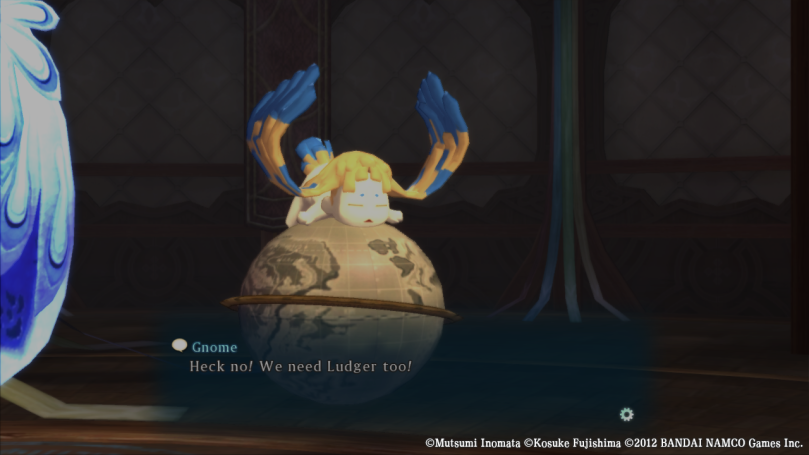
unduly favoring a character by changing other characters or the environment in inappropriate ways
In this case, the environment involves game mechanics that were designed to favor Ludger over other characters.
Not only is Ludger designed to be better than the rest of the cast, Xillia 2 also nerfs some of the returning characters. Another character who is a martial artist, Jude, has his speed cut and some of his other moves changed to make him all around worse than he was in the first game. In the story itself, the first Xillia often mentioned that Jude was a good cook. However, since being a good cook is a major part of Ludger’s character, this detail about Jude is never mentioned in Xillia 2. The game makes changes both story-wise and mechanics-wise to put Ludger over the other characters in the story.
An even more specific example is a major mechanic from the first game: Link Artes. Link Artes have two characters team up to perform a combined attack. All of the best Link Artes are with Ludger and another party member. Other party members have their own, but they are for the most part inferior to those involving Ludger. Some of the Link Artes are even programmed to place Ludger in a more advantageous position relative to the enemy compared to the other character involved. Special cinematic attacks called Mystic Artes have a similar bias: Ludger has special Mystic Artes with every character. No other character possesses as many dual Mystic Artes.
He also has a transformation mode that temporarily removes all other party members from the battle field and lets him do combos without limit for a brief period of time! No one else has anything approaching this ability. It’s even required for one battle in the main story. You’d better use Ludger or else!
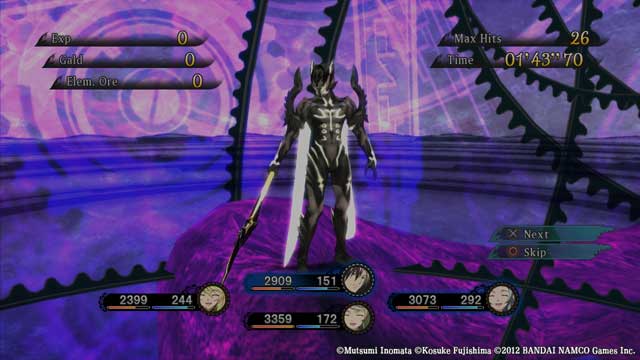
often cause canon characters, established story lines, and the very inner consistency of the canon’s reality, to behave wildly out of bounds
Xillia 2 retcons major parts of the first Xillia’s backstory to accommodate Ludger and the rest of his family. In fact, Xillia 2 feels nothing more than a story all about the inter-dimensional drama of the Kresnik family. Suddenly the plot revolves around this one group of people, and it starts to feel as though nothing that the player accomplished in the first game even mattered. As a result of the retcons, the intricate worldbuilding of the first Xillia loses much of its consistency.
Alternate dimensions, which did not exist in the first game, are also yet another example of the story and world being twisted to accommodate Ludger and his family. After all, Ludger has the power to destroy these worlds, which is a major part of what makes him so important to the story.
As for established canon characters, Xillia 2 goes out of its way to show how much everyone loves Ludger. Whereas in the first Xillia, much of the story had the main cast gradually growing to trust one another, no such thing occurs in Xillia 2. Within 5 minutes of meeting Ludger, almost every returning character from the first game immediately falls in love with him. In fact, there’s an affection system wherein the player is encouraged to get every character to become best buddies with Ludger. Nevermind personal chemistry or anything: everyone ends up liking Ludger even if youmake decisions that give lower affection bonuses.
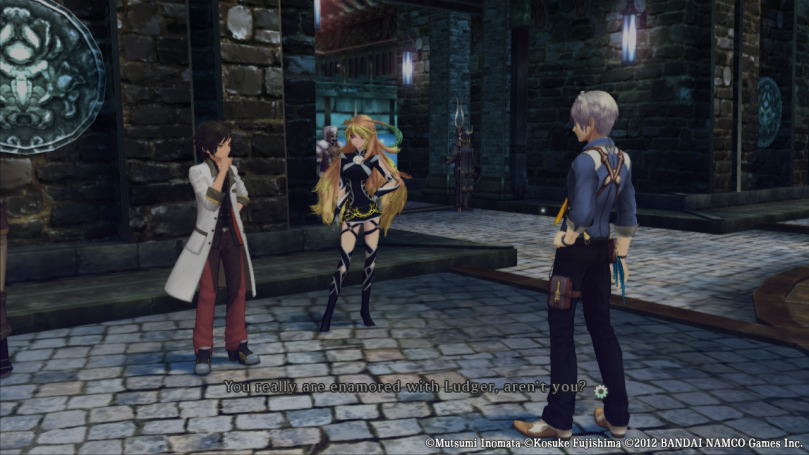
This culminates in the side episodes focused on characters from the first game. Since the player must have Ludger in the party at all times, Ludger also participates in these often very personal character episodes. In some cases, Ludger being there at all makes no sense as he has no connection whatsoever to what is going on. This leads to some incredibly awkward scenes. Yet at the end of most of these character episodes, the character involved always thanks Ludger for helping them through their tough situation. Even if all Ludger did was stand there and say nothing (since he’s silent and all). This really killed my willing suspension of disbelief.
shattered their Willing Suspension of Disbelief
Seriously, my willing suspension of disbelief quit about halfway through this game.
I didn’t find Ludger to be a believable or engaging character at all. He comes out of nowhere, as I mentioned before. He has no real prior connection to the world or characters. He is far, far too competent considering his established backstory. Everyone begins trusting him far too quickly when in the first Xillia characters had to build trust between each other. And if all that wasn’t enough, there is even an alternate ‘bad ending’ where the player (as Ludger) must kill the entire cast of the first game. In fact, this event has already occurred in an alternate dimension as part of the main plot. Thus, the game establishes that Ludger is stronger than the entire cast of the first game combined despite the fact that the cast from the first game is composed of people ranging from those with far more combat experience than Ludger has to an actual deity. It doesn’t matter who they are or even what their whole life history contributes to their abilities, Ludger is stronger than all of them because he’s just THAT special!
I felt like I was reading some teenager’s self-insert fanfiction while playing through this game and it really took me out of the story. I was really tired of everything revolving around Ludger by the time I got to the end of the game.
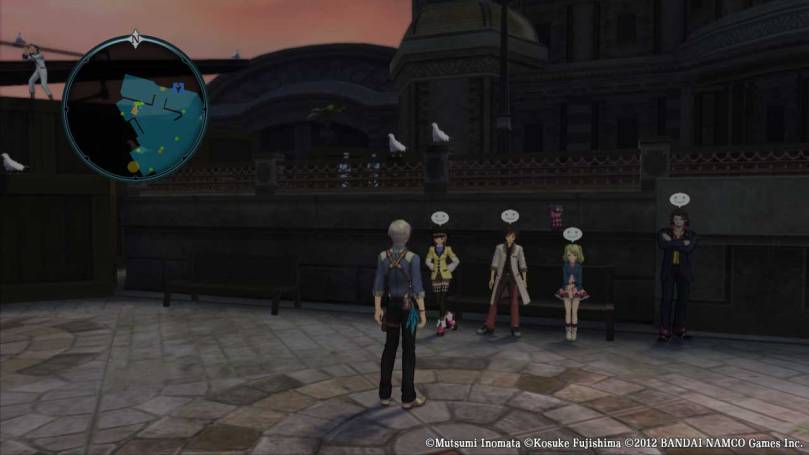
I want to be clear: I don’t hate Ludger as a character. I dislike how he was incorporated into the story and world. On his own, Ludger is actually an amusing character. However, when the game tries to convince me that the entire world revolves around him and his obnoxious family, I start taking issue with his role as protagonist. If he had been given his own game where he could be better established in the world and given more organic development, I think I would have really enjoyed him as a protagonist.
The Bad Ending aka ‘Death by NEET’
Finally, we get the culmination of many of the bad writing practices I’ve already outlined. The cherry on top of Xillia 2’s terrible writing is… the bad ending!
In this ending, the player (as Ludger) can make the choice to save his brother… at the cost of the lives of the entire cast of the first Xillia game. I am not joking: you must kill all 8 of the other playable characters in a very difficult boss fight in order to get this ending. The payoff? A touching scene between Ludger and his brother as they walk away from the scene of the slaughter to… an uncertain future. Nevermind that Julius will die anyway. Nevermind that the plot points to the world ending when Ludger shirks his responsibility so that he can save his brother.
After playing the first game and getting invested in the characters and world, the bad ending is a big “What?” moment. I get it, it’s dark and sad. I guess? The problem is that the bad ending is dark and sad in an incredibly stupid way.
Here’s another example that may help frame this scene: Your favorite TV show has just started its second season. You’ve been really excited due to the rumors you’ve been hearing over the summer break about what new, awesome things this season will introduce. The first episode airs and you eagerly tune in. You’re immediately introduced to a character you’ve never seen before. Oh, some new character? That’s cool. As the season goes on, however, you notice that the characters you enjoyed from the first season are getting less spotlight than this new character. Not only that, certain details about the world in which the show takes place from last season seem to have been changed to revolve around this new character. Suddenly there’s plot holes everywhere. And how come he’s so much better than everyone else in his career when he just graduated from college?
Now imagine that season 2 ends rather unsatisfactorily with no plans for a 3rd season. The DVD comes out and you find out that it has a new ending included as bonus content! In this ending, the new character suddenly turns against the older characters and kills them all! What’s more, he does this for the sake of the barely there love interest that the writers were clearly trying so hard to get the viewer to care about. The commentary from the creators acts like this ending is some kind of poignant, sad moment full of emotion. Unconvinced, you look back through the season and realize that this situation could have easily been avoided and that ultimately the writers were just going for pure shock value just because they could and because it’s dark.
You find out later, after the show’s canceled, that the show runner really had a thing for the new character’s actor and wanted to shove him down everyone’s throats to the point that he had the writers change the script to accommodate this new character.
That’s the best way I can describe my experience with Tales of Xillia 2 and its bad ending via another form of media. It’s an optional ending, yes, but the fact that the writers even went there just aggravates me. It’s consistent with all of the other pointlessly harsh things that happen in the rest of the game.
To sum up the bad ending: the player ends up trading the lives of the entire cast of the first game, a cast that the player has gotten to know over 40+ hours of gameplay, for some new protagonist and his brother who, as I argued earlier, was absent for most of the game while various devices in the game scream at the player to care about Ludger’s big brother because his life was so, so sad (according to secondhand information).
That’s it. That’s Tales of Xillia 2’s writing laid bare. Killing off characters for stupid reasons. And you must love their shiny new protagonist. You must feel bad for him because other NPCs fill in his backstory for you! You must be sad for his brother because the game keeps telling you how much Ludger loves him!
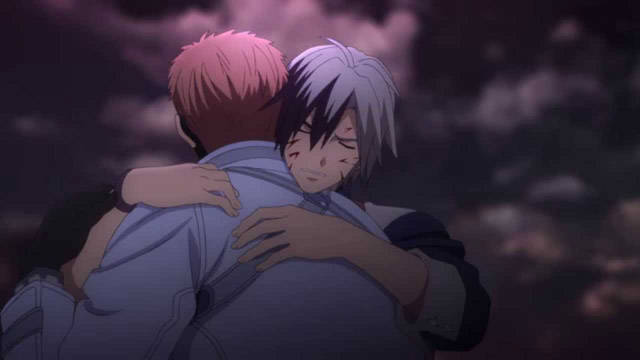
In conclusion, nothing meaningful was accomplished except Bandai Namco making a quick buck
The bad ending accomplishes nothing. Honestly, I’m reminded of people’s criticisms of Batman vs. Superman and Zack Snyder’s approach to the characters. Oh sure, you’ve set up this dark story where a lot of people are killed, but so what? Why should I as the viewer care? What are you accomplishing with your writing?
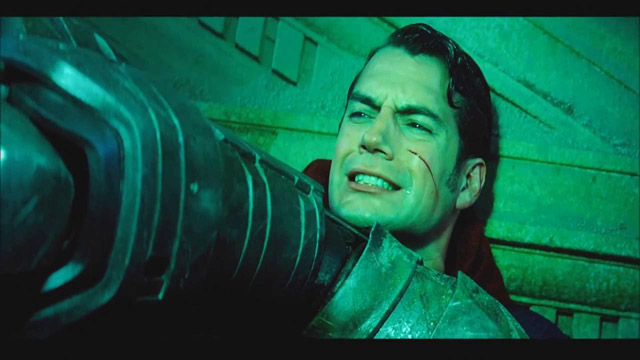
Ultimately, that’s my reaction to Xillia 2’s bad ending and the game overall. Why? What did this extra story really accomplish as a continuation of the first game?
My conclusion: Not much was accomplished. Except generating another game within a year that Bandai Namco could sell to piggy back off of the first game’s wasted potential that left players wanting. That’s Tales of Xillia 2 in a nutshell for you, folks. An excuse to recycle assets with a plot driven by the need to use as few resources as quickly as possible. You can argue that every game is ultimately just a piece of software sold by a company to make money, but never have I see a game as cynically produced as Xillia 2. Instead of getting one complete game for the Tales of series’ 15th anniversary, we got two mediocre games that both feel incomplete in different ways.
This post focused mostly on the main character and why the way he was written bothers me. I didn’t even get into the game’s obnoxious padding done via its debt system where the player is forced to grind fetch quests and other means of gaining cash to progress the story. Alongside the disingenuous writing, that mechanic felt like insult added to injury.
Thus ended my interest in the Tales of series. Thanks for disrespecting your fans, Bandai Namco.
Note: The next title in the series, Tales of Zestiria, was released as a 20th anniversary entry. Due to issues with marketing and the game once again being released as a rushed product, the game faced heavy backlash in Japan. Not too long afterward, the producer for the series that many blame for recent Tales of games’ production problems, Hideo Baba, was let go from Bandai Namco. He is now working on a new project sponsored by Square Enix because for some reason I can’t fathom they wanted to give him money to make a game. Good luck with that, Square Enix.
While I do not own a Playstation 4, I have heard good things about the newest entry in the series, Tales of Berseria.
Updated Note (5/16/2020): Hideo Baba resigned from Square Enix in March 2019. Studio Istolia, of which he was representative director, never produced a game. The game that it did tease, called Project Prelude Rune, has been canceled and the studio no longer exists. I have no idea if Baba is still in the industry or if he plans to make another game. Given his history… I think the industry is better off without him.
Credit for the fridge art goes to my good friend, the talented kani.
:martha:
This right here sums up why this game was a huge let-down for me and all of the Tales of fans as well. People shouldn’t have to waste time with a game that does not connect very well to the first. I call for a redo/remake of the sequel to be better than this slop.
I’ve played most of these games… And Tales of Xillia II is the first one I’ve come across where I have no interest in it all. What you don’t mention here is how it is mostly filler. Almost all the gameplay is “grind for the next area by paying off the debt.” Whoah, that’s right, this is mortgage simulator 2015!